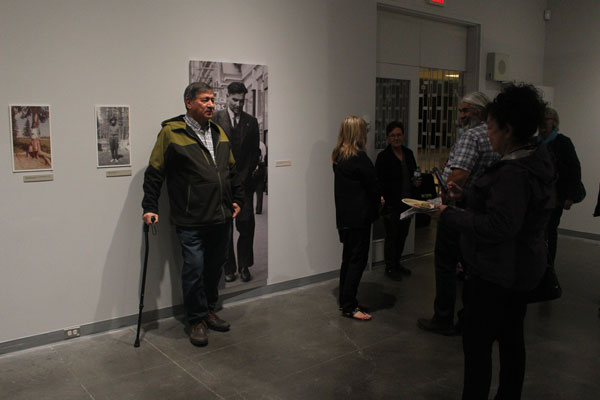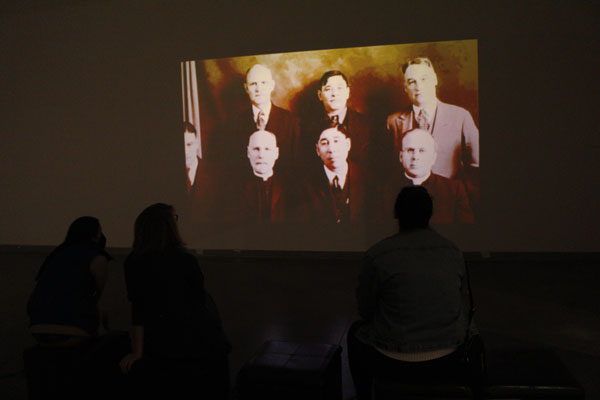
James Brady was a noted Métis Activist but he was also an amateur photographer, and the latest Mann Art Gallery exhibit aims to show off that side of his life.
‘Enclosing Some Snapshots: the Photography of Métis Activist James Brady officially opened on Friday. Curators Paul Seesequasis and Marcel Petit said the project allows people to see the world through James Brady’s eyes.
“It really started off as photos of Jim Brady,” Petit explained. “Jim Brady was this amazing, amazing Metis leader. He was a prolific photographer and … he took pictures of everywhere he went, so he tells a story of Saskatchewan.”
Brady’s life (1908-1968) is intricately linked to the history and politics of Métis communities in Alberta and Saskatchewan. Petit said the photographs are evidence of Brady’s deep attachment and commitment to the dignity and rights of Métis peoples at a time of impoverishment and denial of rights by provincial and federal governments.
Brady documented his life until the time of his mysterious 1967 disappearance near La Ronge with his friend Absolom Halkett.
“I think this whole thing about Jim Brady, because now it has been almost 54 years since he went missing, is that he is such an important figure for Metis people in Canada,” Petit said. “(He’s) big in Western Canada but his photography really helps tell the story about how we were living at that point in time.”
The touring exhibition started with Seesequasis curating a show at the Glenbow Museum in Calgary that was set to open right when the COVID-19 pandemic began in March 2020. Although various aspects of the exhibit were visible online, many of the photos weren’t.
Petit said they wanted to give residents a chance to view them in person, which led to the current exhibit.
“You have to see these pictures in public in person,” he said. “I got ahold of (Paul) and said let’s do this. Let’s go across Saskatchewan and show these photos. It was meaningful here just for the fact this is close to where he lived up in Cumberland.”
Some of Brady’s family was in attendance for the reception at the Mann. Petit said that made the show even more meaningful, as did hosting in in Northern Saskatchewan.
“We really did this show just to show what he saw and really give him some respect for what he did and who he was as a leader,” Petit explained.
He explained that it was really meaningful to be in Prince Albert and moreso in northern Saskatchewan. Petit explained that they went through his photos from the 1930s to 1960s and it tells his life in that period of time.

“You will tell in one period it’s in Cumberland House because that’s where he was living and then 30s and 40s were in different parts, some may be in Alberta and some may be in Saskatchewan, and that was just it,” Petit said.
Elder Liz Settee said a prayer before a speech by Mann Curator Marcus Miller and Petit.
A documentary film directed by Marcel Petit – Jim Brady: In the Footsteps of the Métis Leader supplements the exhibition along with 22 photographs by Everett Baker from the archive of the Saskatchewan History & Folklore Society.
“I love Everett Baker as much as I love Jim Brady because of photography,” Petit said. “I’m a photographer myself because (of) the stories they tell in the pictures and it’s one thing that I tried to teach. When I do photography classes I really tell people I said you have to respect a photo because it tells so many stories. And if you look at the photos they really mix with Everett.”
They also took the exhibit to North Battleford and supplemented the work with the paintings of Allen Sapp. Petit said that the photographs really complement each other well in the Mann exhibit.
Petit made the film because Brady is important to him.
“The film is about Jim Brady, about what he did as a person, what he did while he was being an activist and really just about him being an activist. He tried to do better for Metis people,” Petit said.
Petite explained that Brady was a reason that he also became an activist.
“In the early 1980s I was trying to figure out where I came from as a Metis person. I knew I was Metis, I was proud to do it but I didn’t know what that meant and then my uncle Claude Petit gave me the book One and a Half Men,” Petit said.
The book The One-And-A-Half Men: The Story of Jim Brady and Malcolm Norris, by Murray Dobbin, really accelerated his interest in Brady’s photography.
“I read that and I am going, ‘who is this guy? I want to be this guy. I’m going to be Jim Brady,’ and so it was a lot of teaching me about who I am but also teaching me how to be an activist in a way that was loud but not loud at times.”
The exhibit runs at the Mann Art Gallery until Nov. 5.
michael.oleksyn@paherald.sk.ca
